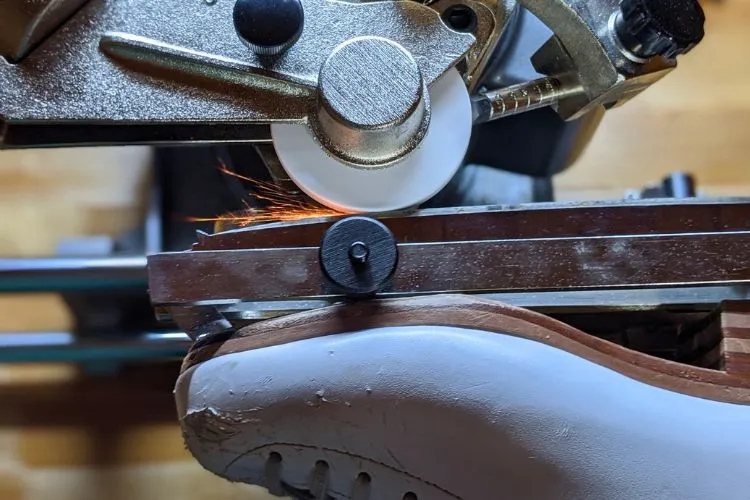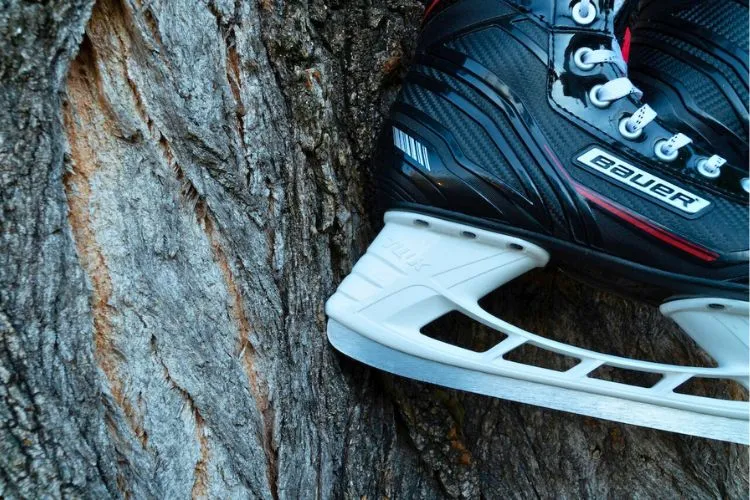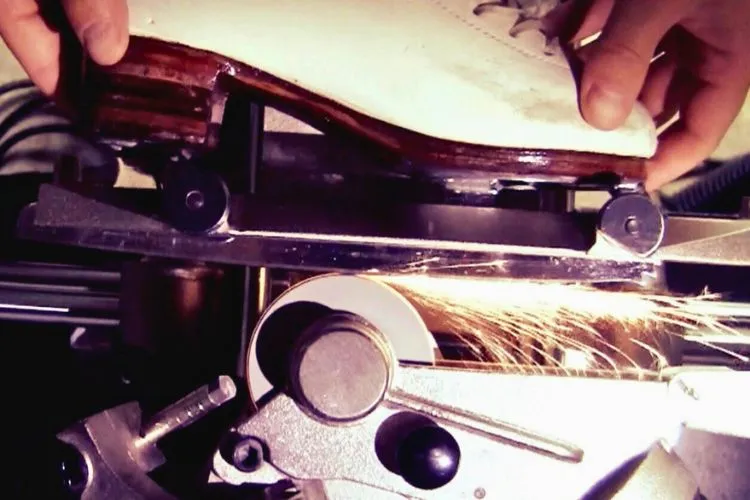Maintaining sharp blades on your ice skates isn’t just a matter of preference—it’s a crucial aspect of ensuring safety, performance, and prolonging the lifespan of your skates.
Throughout this guide, we’ll delve into the intricacies of how to sharpen ice skates, helping both novices and seasoned skaters understand why it’s essential and how to execute it correctly.

Understanding Ice Skate Sharpening
Ice skate sharpening is the process of refining the blades of your skates to maintain optimal grip and control on the ice. Sharp blades are key to achieving the precision and speed that skaters aim for.
When the blades of the skate are sharp, they dig into the ice with less force needed, allowing for smoother glides, sharper turns, and more effective stops.
When to Sharpen Your Ice Skates?
Knowing when to sharpen your skates is vital. There are clear signs that it’s time for sharpening: you might find yourself slipping more often, struggling with movements that used to come easily, or observing nicks and a general dullness on your blades.

As a general guideline, sharpening after every 20 hours of skating is recommended. However, this can vary based on your skating frequency and style.
Preparing for Sharpening
Ahead of sharpening, ensure your blades are clean. Dirt, rust, and debris can affect the sharpening quality. After cleaning, inspect the blades for any damage. Deep nicks or excessive wear might require professional attention or blade replacement before further sharpening.
Tools Required for Sharpening Ice Skates
For those opting to sharpen skates at home, a sharpening machine or a sharpening stone, a honing stone, and a blade jig are needed.
These tools help in achieving the precise angle and sharpness desired. Professional sharpeners might use more advanced equipment, but these basic tools are sufficient for personal use.
How to Sharpen Ice Skates?
Setting Up the Sharpening Machine
If using a sharpening machine, first, you must set it up correctly. Calibration is key to ensuring that the blades are sharpened evenly. Follow the manufacturer’s instructions closely to set the correct angle for your blades.
Sharpening Process
The sharpening process involves several steps. Secure the skate firmly in place. Select the correct hollow – the concave groove on the blade’s bottom – based on your weight, skating style, and the ice’s hardness.
Then, gently glide the skate across the machine or stone, maintaining consistent pressure and speed. It might take several passes to achieve the desired sharpness.
Finishing Touches
Post-sharpening, a honing stone is used to remove any burrs or imperfections from the blades. This step is crucial for ensuring the smoothness of the blade’s edge. A final check for sharpness and symmetry wraps up the process.
Safety Tips
Safety cannot be overstated during the sharpening process. Always wear protective gloves to prevent cuts. Pay attention to the manufacturer’s guidelines if you’re using a sharpening machine to avoid accidents.
Alternative Sharpening Methods
While manual and machine sharpening are common, alternative methods exist. Hand-held sharpeners provide a quick fix but might not offer the precision of a machine.
Professional sharpening services, on the other hand, guarantee expert results for those unsure about doing it themselves.
Troubleshooting Common Sharpening Mistakes
When sharpening ice skates, it’s not uncommon to encounter challenges that can impair skating performance. Here’s how to address some common issues:

- Uneven Blade Edges: Uneven edges can hinder balance and precision. To correct this, inspect blades after sharpening using a blade checker and adjust the sharpening technique accordingly to ensure even edges.
- Incorrect Hollow: The wrong hollow can affect glide and grip. Skaters should experiment with different hollow depths to find the sweet spot for their style and ice conditions.
- Overheating the Blade: Excessive heat can soften blade steel. Prevent this by avoiding prolonged friction, and cool the blade intermittently during sharpening.
- Burrs on the Blade: After sharpening, burrs can affect the skate’s bite on the ice. Remove them thoroughly using a honing stone or strop for a smooth edge.
- Using the Wrong Equipment: Ensure you’re using appropriate tools for your blades. When in doubt, seeking professional sharpening services is advisable for the best results.
You may also read: Types of Ice Skates | How Tight Should Ice Skates Be?
Frequently Asked Questions (FAQs)
How do I know the correct angle to sharpen my ice skate blades?
The correct angle, or radius of hollow, depends on various factors including your weight, skating style, and the ice conditions. It’s often best to start with a standard angle and adjust based on your preferences and performance.
Can I sharpen new ice skates, or should they be sharpened by a professional?
New ice skates often come pre-sharpened, but it’s not uncommon to need a touch-up for optimal performance. Whether you do it yourself or seek a professional depends on your comfort and skill level.
How often should I sharpen my ice skates if I skate frequently?
The rule of thumb is to sharpen skates after every 20 hours of use. However, frequent skaters might find they prefer or need more regular sharpening. Listen to your performance cues and inspect your blades regularly.
Can dull blades be sharpened, or should they be replaced?
Dull blades can usually be sharpened unless they are damaged beyond repair. Inspection will help determine the best course of action. In cases of severe damage, replacement might be the only option.
Is it possible to over-sharpen ice skate blades, and what are the implications?
Yes, over-sharpening can occur, leading to blades wearing down prematurely or becoming too thin, which can reduce stability on the ice. It’s essential to sharpen only as needed and to monitor the blade’s condition closely.
What are the differences between a manual and an electric skate sharpener, and which is better for beginners?
A manual sharpener offers simplicity and control, making it suitable for beginners. Electric sharpeners provide speed and convenience but might require a learning curve to achieve the desired results. Beginners might start with manual sharpening to gain an understanding of the process before moving to electric models for efficiency.
Conclusion
The importance of keeping your ice skates sharp cannot be overstated. It influences not just your performance but your safety on the ice. With the right tools and techniques, sharpening your skates becomes a manageable part of your skating routine. Don’t overlook this crucial maintenance step—sharp blades are the foundation of great ice skating.

Matthew James is a passionate skater who wanted to create a platform to share his love for skating with others. With a vision to create a vibrant community of skaters, he aims to provide a space where skaters of all levels can connect, learn, and grow together.
